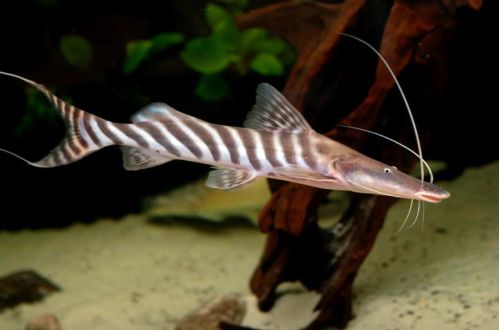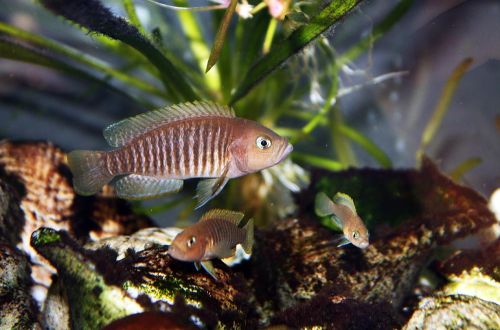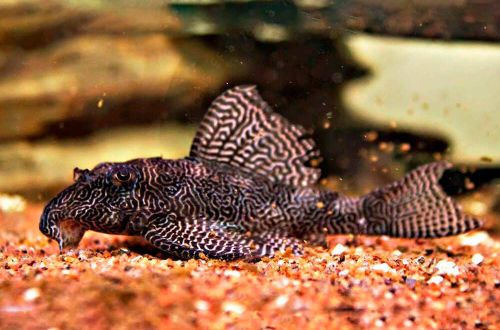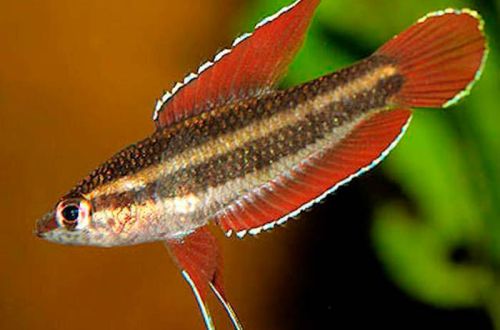
tiger catfish
Tiger catfish or Brachyplatistoma tiger, scientific name Brachyplatystoma tigrinum, belongs to the family Pimelodidae (Pimelod or flat-headed catfishes). Big beautiful fish. Compatible with other freshwater species, but large enough to be accidentally eaten. All small fish will certainly be considered by the catfish as food. Due to its size and diet, it is rarely used in the hobby aquarium.

Contents
Habitat
It comes from the upper Amazon basin in Brazil and Peru. Inhabits sections of rivers with rapid rapid flow, often found at depth at the base of rapids and waterfalls. Young fish, on the contrary, prefer calm waters in shallow water with dense aquatic vegetation.
Brief information:
- The volume of the aquarium – from 1000 liters.
- Temperature – 22-32°C
- Value pH — 6.0–7.6
- Water hardness – 1–12 dGH
- Substrate type – any
- Lighting – subdued
- Brackish water – no
- Water movement is strong
- The size of the fish is about 50 cm.
- Food – products from fish, shrimp, mussels, etc.
- Temperament – conditionally peaceful
- Content alone or in a group
Description
Adults reach a length of up to 50 cm. Fish exported for sale are usually 15-18 cm. It is not uncommon for amateurs to acquire these, as they think, small catfish, and later, as they grow, they face the problem of what to do with such a big fish.
The catfish has an elongated slender body and a flat wide head, on which are long antennae-whiskers – the main organ of touch. The eyes are small and largely useless in conditions of poor lighting and high turbidity of the water. The color pattern of the body consists of narrow dark vertical or oblique stripes, rarely broken into spots. The base color of the body is pale cream.
Food
A carnivorous species, in nature it feeds on both living and dead fish. In an artificial environment, he will accept pieces of white fish meat, freshwater shrimp, mussels, etc. On occasion, he will definitely eat other inattentive inhabitants of the aquarium if they fit in his mouth.
Maintenance and care, arrangement of the aquarium
The optimal size of the aquarium for one individual starts from 1000 liters. When keeping, it is important to ensure a strong movement of water to mimic natural conditions. The layout must be appropriate. There can be no talk of any graceful designs and living plants. It is necessary to use a sand and gravel substrate with heaps of large stones, boulders and several massive snags.
The size and diet of the Tiger catfish generates a lot of waste. To maintain high water quality, it is renewed weekly for fresh water in the amount of 50–70%, the aquarium is regularly cleaned and equipped with all the necessary equipment, primarily a productive filtration system.
Behavior and Compatibility
Despite its carnivorous nature, it is a peaceful calm fish, safe for other species of comparable size. As neighbors in the aquarium, you should select only those fish that can live with strong water movement.
Breeding / breeding
Not bred in an artificial environment. For sale, either juveniles are caught in nature, or grown in special nurseries in dammed river banks.
In the Amazon, two periods are clearly expressed – dry and rainy seasons, when a part of the tropical forest is temporarily flooded. In nature, spawning begins at the end of the dry season in November, and unlike members of its genus such as the Golden Zebra Catfish, they do not migrate to flooded areas to lay their eggs. It is this feature that allows them to be bred on the spot, in their habitats.
Fish diseases
Being in favorable conditions is rarely accompanied by a deterioration in the health of fish. The occurrence of a particular disease will indicate problems in the content: dirty water, poor quality food, injuries, etc. As a rule, eliminating the cause leads to recovery, however, sometimes you will have to take medication. Read more about symptoms and treatments in the Aquarium Fish Diseases section.





